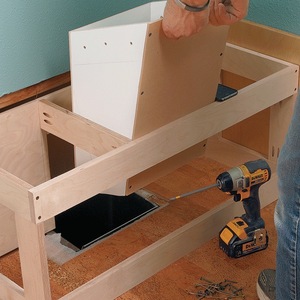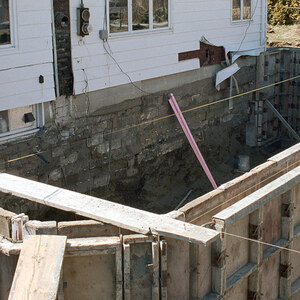The adventure of discovery continues–found out Thursday that my washer is hooked up to drain into the footing drain tiles! No wonder our basement is wet (but it’s a clean wet)!
Moved into wife’s house when we got married ten years ago and every year on March 24th almost to the day, the drain water from the washer backs up through the floor drain. Thursday a new (to me) guy comes from the same company we’ve always used to ream out the sewer pipes to remove roots and this time he tells me the problem is that washer is not (at least not directly) connected to sanitary sewer, but is connected to the floor drain which only goes into the footing drain tiles. These may (or may not) be connected to the sanitary sewer (as required by municipality when house was connected to sewer), or it may be connected to the storm sewer (or not).
It wasn’t until last year that another guy noticed that the washer drained into the floor drain and he cleaned out that drain that he said went through the roots of a forsythia bush for about 8′ and into the main line to the street. New guy says he’s not sure it ever goes to the street and that the floor drain goes into footing drain! He cleaned out the tiles around the footing and the sanitary sewer line (all 150 feet of it!).
Anyway, I plan to tie the drain hose into the house main waste line that runs behind the washer at about 40 ” off the floor (and then angles down and around the corner where it exits through the basement wall at about 24″ off floor). I know there must be an air gap, and I think there should be a trap. Anything wrong with putting a “T” on the 8″ PVC house line so that the trap enters at the side and the “stand pipe” is a 3″ PVC pipe that has its open end a few inches above the main drain, with the washer drain hose clamped into the open end? Open end of the stand pipe would be the required 34″ to 72″ off the floor.
I’ve seen lots of washers with no trap, but am not keen on the idea of sewer gas entering there. Most washers I’ve seen empty into a tub or a standpipe that comes out of the floor.


















Replies
I'm no plumber but have a few comments...
"the 8" PVC house line " WOW!!! is your bathroom a 10 seater or what!!! :-)
On a more serious note, you may need to think about venting the washer drain in addition to just where to make a drain connection. Are there any other plumbing fixtures in the basement like a sink or anything? I'm guessing not...
Matt
Edited 3/26/2005 5:43 pm ET by DIRISHINME
I may be wrong, the main drain may only be 6", but I know it's not 4". No other fixtures in basement. I figured since there would be an air gap, venting (with a stack)would not be necessary?
Yea, I guess you are right about the air gap.
I just have the bad visions of poop backing up and comming out your washer drain...
Matt
Yeah, I had visions of the same thing, that's why I wanted the air gap, but from what Hartmann says in following post, that may not be enough, so....
Edited 3/26/2005 6:07 pm ET by Danno
Well you are talking about 2 different things.The trap is to prevent sewer GASSES from escaping.Sewage blockage will keep backing up untill it gets to the lowest point in the system and comes out. The trap won't stop that unless you make the distance between the top and bottom 10 ft.With the top open the sewage will flow onto the floor and not into the washer.Now if you have a common problem of the sewer backing up you could put a check valve in the line (like the type used on sump pumps). But that might slow the discharge down and new washer dump wwater out FAST.
I know what you're saying about rapid discharge of water from washer--had to add a garbage can with a small hole in the bottom to temporarily hold the water or it backed up all over the floor all the time.
For what I just paid for all the cleaning, I could probably have had the lines dug up and replaced (well, almost). Camera is a good idea. We have the old terra cotta tiles for all drain lines outside the house, so I imagine they're in rough shape--lots of mature trees and the lines were put in in 1938, so they may have about had it!
Thanks for all the advice!
You might want to install a utility sink and pump the washer into that.That gives a resivor for the discharge water .
Yeah, I'd like to do that--have a utility sink/laundry tub, but then the drain would be about two feet from the floor and the house drain runs behind the washer at about 48" off the floor. I could run a separate 2" line parallel and under the house drain line until it meets at the stack on the other wall, I guess. Still, the house drain leaves the basement at about 2' off the floor.
You need a vent on the wet side of the trap.Other than it does not have a "funnel" (sink) on it it is just like a sink.Now you can probably get by with wet venting it. However, code no longer allows wet venting if you have a stool on a level above it.But specialy with 6" I suspect that it would work.But if you could find a vent line to tie into I would.If not, personally I would try to go with the wet venting. And if you had a problem with the trap getting sucked dry then add an air admitance valve (Studor vent).Also, depending on how much problems you are having you might want to get a company out that has video cameras and locator service to run both lines and see where they go and you could also see how much problems you have with the roots and the like.
Thanks. You are right, of course, I saw it as a sink, but didn't "see" that sinks have vents. This could be a problem. Nearest vent is about ten or fofteen feet away and on the second floor, or in the other direction about ten feet--maybe could get to that one. The whole house is one bollixed job after another: some knob and tube wiring mixed with Romex, new copper supplies tied to old galvanized without a dilectric union, hot water heat registers not level and installed so fins are the wide way out so covers don't fit, etc..
Sinks have vents, it is just that the connection is made in the walls.Now a friend of mine has a 50 year old house that has been remudled a couple of times. No T&B wiring, but switched neutrals, taped junctions hidden in the walls and the like.And it had a "campground" bath in the basement. Sink wall mounted sink tapped into the CI stack and a tapped into the run under the floor a branch for the toiliet and another branch for a floor drain around which block walls had been built. The shower walls was the only "shelter" for the whole area.And the same mix of copper and galvanized. Some with and without dielectrics. BTW, the galavanized was like new except where it connected up to some copper without the dielctric. The fittings broke when I tried to fix it right and the rest was correoded together. Had to replace the whole run.I 'think' that it was orginal orginal, but had to tell. Anyway there did not to be any problem with the lack of venting.And I rebuilt it with real fixtures and walls. Had to bust up the concrete and adjust the location of the toliet and install fits to get to a shower basain.And it still works fine.